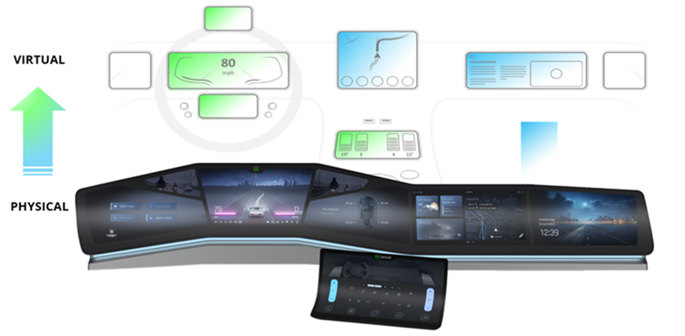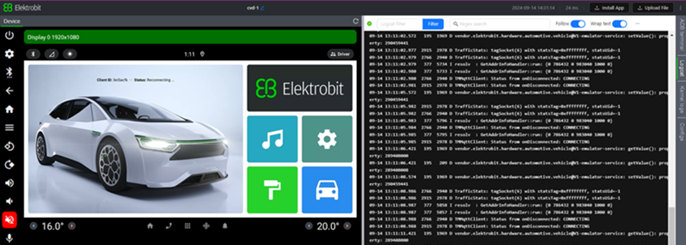
The door opens with a soft click, intuitively. Lights inside the cabin adjust to your preferred brightness. The seat moves into place like it remembers you, which it does. Your digital mirrors show a clear view of the road, enhanced with real-time safety alerts. Your favorite playlist fades in just as your smart assistant suggests a better route around construction. The drive hasn’t even started, and already it feels seamless, personal, and intuitive.
From intuitive entry to real-time, personalized guidance, modern digital cockpits redefine what drivers expect, and software-defined vehicles (SDVs) make it possible. Vehicles are rolling extensions of our digital lives, and the in-vehicle infotainment (IVI) system has become much more than just an entertainment hub.

It’s the center of user experience, brand connection, and yes, innovation. The question for OEMs isn’t whether to invest in next-gen infotainment; it’s how to do it in an ever-changing, complex SDV environment.
Building great relationships through IVI
Infotainment may have started as a nice-to-have feature. This is no longer the case. It’s the foundation for a new kind of relationship between drivers and vehicles, and between customers and brands. Personalization, self-expression, and connectivity define how people interact with their cars.
Infotainment also represents the fastest and most cost-effective path to building a software-defined vehicle, enabling high-value SDV use cases through the cockpit alone, without requiring a complete architectural overhaul.
The SDV allows for deep integration between digital lifestyles and the driving experience. Done right; it creates emotional loyalty, not just product satisfaction. It’s not about screens for the sake of screens. It’s about giving drivers a space that reflects who they are, adapts to their needs, and feels alive with possibility.
IVI is ready to deliver personalized, intelligent experiences: now
Next-generation IVI systems must go far beyond music and navigation. They must provide a connected, intelligent, and customized user experience. This means:
- Cluster instruments and digital mirrors that deliver key vehicle information with precision and style, including ADAS visualizations and safety cues.
- Smartphone integration and entertainment that bring streaming, gaming, and navigation into a unified environment.
- Multi-channel human-machine interfaces (HMI) using sensors, gestures, voice, and eye tracking to respond intuitively to user behavior.
- Generative AI assistants evolve into digital companions, always ready to help and always reflect the brand’s personality.
- Personalized UI elements like widgets, visuals, sounds, and cabin lighting, all tailored to the individual.
- Consistent experiences inside and out, from cockpit displays to exterior-facing screens.
This level of UX complexity demands more than sleek and beautiful interfaces. It requires serious software expertise and scalable solutions without compromising performance or security.
Scalability keeps SDV development future-ready
To keep up with rising expectations and shrinking timelines, OEMs must be able to scale across platforms, regions, and product lines. This means building infotainment systems that are flexible at their core, ready to evolve as user needs, regulations, and hardware landscapes shift.

From concept onward, OEMs need architectures and development environments that are platform-agnostic, modular, and future-proof. Whether deploying a luxury flagship or scaling down to a compact EV, solutions need to adapt without forcing OEMs to start over. Scalability ensures investments last longer, and teams can move from pilot to production at speed.
Enable next-level user experience
Behind the scenes, a powerful orchestration of hardware and software makes SDV infotainment possible. Key enablers include:
- System on chip (SoC) and high-performance computers (HPC) that handle real-time rendering, data fusion, and AI-driven features.
- Zonal architectures that streamline data flow and reduce wiring complexity, enabling modular, cost-efficient upgrades across models. Open system architectures with connectivity that allow for seamless over-the-air updates and region-specific compliance.
- Flexible design environments with robust APIs that empower OEMs to design unique HMIs while keeping development efficient.
- Virtual development tools and simulation frameworks that let global teams collaborate asynchronously, with hardware-agnostic testbeds that shorten time to market.
These technologies help carmakers shift from fragmented feature development to holistic SDV user-experience design.
Why Elektrobit is the ideal SDV infotainment partner
Building these systems isn’t just about technology, it’s about trust. Elektrobit has been shaping automotive software for decades and is now an award-winning frontrunner in software-defined vehicle development. From low-level software integration to UX and UI design tools, Elektrobit makes it easier to manage complexity and stay ahead of consumer expectations.

Our partnerships with industry leaders like ARM, Qualcomm, Nvidia, Intel, Infineon, AMD, Google, Amazon, AWS, NXP, Here, Epic Games, and many more means you get scalable solutions at any scope for any target environment. Our virtual development tools and proven product portfolio ensure your teams can collaborate globally, test safely, and move faster, from concept to rollout.
Infotainment is the beating heart of SDVs
Software-defined vehicles are here, and in-vehicle infotainment is more than a feature. It’s the first impression, the lasting memory, and the emotional core of the driving experience.
The moment a driver steps into the cockpit, everything should feel tailored, thoughtful, and ready. That’s what they’ll remember. That’s what sets a brand apart. With Elektrobit, the experience you design today will scale with the innovations of tomorrow – and still feel just as seamless, personal, and intuitive as it did on day one. We help you get there; end to end.
Explore more
Discover Elektrobit’s end-to-end SDV development solutions.
Discover Elektrobit’s virtual IVI development solution.
Watch the video on Elektrobit’s virtual IVI development solution.
Watch the video on SDV levels, jointly created with Eclipse foundation.



